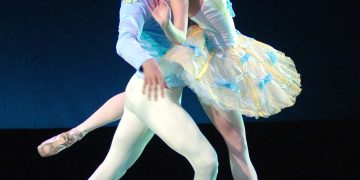
Roar, Rumble and Snort: San Diego Zoo Stories: A Day in the Life of a Zookeeper
By Dani Dodge
 The sky is dark as animal keeper Rick Schwartz makes his way through the San Diego Zoo for the 6 a.m. shift. His flip-flops make a quiet slap on the cold pavement.
The sky is dark as animal keeper Rick Schwartz makes his way through the San Diego Zoo for the 6 a.m. shift. His flip-flops make a quiet slap on the cold pavement.
As he approaches the Children’s Zoo, the quiet is broken by the “Hellos” of parrots, the squeals of spider monkeys and the grunts of a fossa he has helped raised since it was only a day old.
Rick quickly changes into his khaki keeper uniform and waterproof boots so he can return the greetings.
“When I come to work, there are 30 or 40 animals here happy to see me,” says Rick, who has worked in the Children’s Zoo since 2000. “I am ridiculously lucky.”
The day ahead of him includes lifting rocks, preparing animal diets, cleaning out more than a dozen enclosures, a television appearance, and at least five loads of laundry. But each step of the way, he has help. For instance, an African gray parrot named Kizzy perches on the warm laundry cooing encouragement as Rick folds.
After Rick is in uniform, the day begins — just like any office job — with a meeting. Lead keeper Clint Lusardi directs the meeting, giving out the day’s assignments, and reviewing which animals each keeper will be caring for that day.
The meeting breaks up, and Rick is off to make sure the 15 animals he is responsible for that day are all in their appropriate places and feeling well. The rock hyrax has fluffed his fur into a puffy ball and is sitting under the heat lamp. The meerkats tumble over each other vying to be closest to Rick while crying out “Whoop, whoop, whoop.”
“One, two, three, four meerkats — you’re all accounted for,” Rick says.
Next, he coos at the ocelot, which playfully stalks him. Then, a toucan, a tamandua, a serval and more.
Then it is on to making the animals’ enclosures fresh for the day. The cleaning requires lifting rocks, stooping under tree limbs and grabbing armloads of smelly hay. It includes hand-washing food dishes, laundering the animal bedding, and chopping fruits and veggies. Rick doesn’t complain.
“It is labor, but it doesn’t feel like work,” he says.
As he cleans the meerkats’ enclosure, the curious pint-sized mammals crowd around to investigate his every move.
“Makes you feel like you have another supervisor,” Rick quips.
The schedule would be hectic, except for the fun of it all. Much of the cleaning and feeding is done before the public comes through the zoo gates at 9 a.m. Then the greeter parrots are taken to their perches near the bus loading depot and the Children’s Zoo entrance. Only later in the day is there time for animal training and public interaction.
And on this day, Rick is also doing a live broadcast during the 11 a.m. news at the KFMB studios.
So he puts Cocoa, the armadillo, in a crate for a trip to the studio. A zoo public relations representative drives him and he takes the moment of sitting to study his “copy points,” messages he will try to share with viewers of the morning newscast.
When the cameras come on, the show’s hosts, Dan Cohen and Nichelle Medina, joke with Rick like old friends as he presents the animal.
“The cool thing about a three-ringed armadillo is it can curl itself up into a completely sealed ball!” he says, showing them the coconut-sized creature.
When Rick returns to the zoo, there are animals to be weighed for health checks and off-exhibit areas to clean. He puts fresh newspaper on the bottom of the rose-breasted cockatoo cages.
He heads to the kitchen to create the animals’ meals. The zoo’s nutritionist has created a specific recipe for each animal, and he flips through a binder to find the recipe for each creature. The produce Rick uses is restaurant quality. As he chops and dices and weighs each item, he laughs at how good it looks.
“Especially the bird diet, it’s a really great fruit salad,” he says, “How much would you pay for that in a fancy restaurant?”
Toward the end of the day, he sets up fun activities for the animals to do while he’s gone: cardboard boxes for the macaws to tear apart, scents for the serval to explore, a “puzzle box” full of chopped yams for the dexterous raccoon to discover.
As he leaves at 4:15 p.m., the animals can’t see him, but know the sound of his footsteps flip-flopping away. They call out with their hoots, squeals and grunts, as if to say “See you tomorrow!”
Dani Dodge is a former newspaper reporter and editor now working at the San Diego Zoo. She can be reached at [email protected].












Discussion about this post